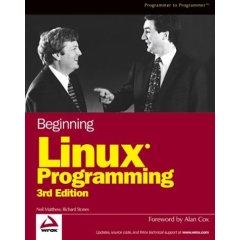| 2020ok Directory of FREE Online Books and FREE eBooks |
Free eBooks > Computers & Internet > Operating Systems > Unix > General > Beginning Linux Programming, Third Edition
Beginning Linux Programming, Third Editionby Neil Matthew, Richard Stones, and Alan Cox  Download Book (Respecting the intellectual property of others is utmost important to us, we make every effort to make sure we only link to legitimate sites, such as those sites owned by authors and publishers. If you have any questions about these links, please contact us.) link 1 About Book Amazon.com Provided you have some previous basic exposure to C and Unix, Beginning Linux Programming delivers an excellent overview of the world of Linux development with an appealing range of essential tools and APIs. The standout feature of Beginning Linux Programming is its wide-ranging coverage of important topics in basic Unix programming. In a series of short chapters, the authors discuss the basics of writing Unix programs in C, with material on basic system calls, file I/O, interprocess communication (for getting programs to work together), and advanced topics such as socket programming and how to create Unix device drivers. Parallel to this, the book introduces the toolkits and libraries for working with user interfaces, from simpler terminal mode applications to X and GTK+ for graphical user interfaces. While you won't be an authority on X or GTK+ after reading this book, you will certainly be able to explore real Linux development on your own after the capable introductory guide provided here. (The book's main example, a CD-ROM database, gets enhanced in subsequent chapters using new APIs and features as the book moves forward.) This text also serves as a valuable primer on languages and tools such as Tcl, Perl, and CGI. (There's even a section that explains the basics of the Internet and HTML.) More than ever, there is no shortage of specific information on Linux programming, but few titles provide such a wide-ranging tour of what you need to know to get serious with Linux development. In all, Beginning Linux Programming gives the reader an intelligent sampling of essential topics in today's Linux. It's a wise choice for aspiring Unix C developers or folks seeking to extend the range of their Linux knowledge. --Richard Dragan Topics covered: Linux overview, compiling C programs, shell programming, pipes, script keywords and functions, Unix file I/O in C, Unix system functions, terminal interfaces (termios, keyboard input, the curses library), memory management, file locking, dbm databases, make and source control basics, man pages, debugging with gdb, processes and signals, POSIX threads and synchronization, IPC and pipes, semaphores, queues and shared memory, sockets, Tcl basics, X Windows and GTK+ for GNOME, Perl basics, HTML and CGI, writing Unix device drivers.
If you have some programming experience and are ready to venture into Linux programming, this updated edition of the bestselling entry-level book takes you there. The authors guide you step by step, using construction of a CD database application to give you hands-on experience as you progress from the basic to the complex. You’ll start with fundamental concepts like writing Unix programs in C. You’ll learn basic system calls, file I/O, interprocess communication, and shell programming. You’ll become skilled with the toolkits and libraries for working with user interfaces. The book starts from the basics, explaining how to compile and run your first program. New to this edition are chapters on MySQL® access and administration; programming GNOME and KDE; and Linux standards for portable applications. Coverage of kernel programming, device drivers, CVS, grep, and GUI development environments has expanded. This book gives you practical knowledge for real wor ld application. What does this book cover? In this book, you will learn how to
Who is this book for? This book is for programmers with some C or C++ experience, who want to take advantage of the Linux development environment. You should have enough Linux familiarity to have installed and configured users on Linux.
The authors guide you step by step, using construction of a CD database application to give you hands-on experience as you progress from the basic to the complex. You’ll start with fundamental concepts like writing Linux programs in C. You’ll learn basic system calls, file I/O, interprocess communication, and shell programming. You’ll become skilled with the toolkits and libraries for working with user interfaces. The book starts with the basics, explaining how to compile and run your first program. First, each concept is explained to give you a solid understanding of the material. Practical examples are then presented, so you see how to apply the knowledge in real applications. What you will learn from this book
Who this book is for This book is for programmers with some C or C++ experience who want to take advantage of the Linux development environment. You should have enough Linux familiarity to have installed and configured users on Linux. Wrox Beginning guides are crafted to make learning programming languages and technologies easier than you think, providing a structured, tutorial format that will guide you through all the techniques involved.
Rick Stones programming at school, more years ago than he cares to remember, on a 6502-powered BBC micro, which with the help of a few spare parts continued to function for the next 15 years. He graduated from Nottingham University with a degree in Electronic Engineering, but decided software was more fun. Related Free eBooks
| Related Tags |












SEND A COMMENT
PLEASE READ: All comments must be approved before appearing in the thread; time and space constraints prevent all comments from appearing. We will only approve comments that are directly related to the article, use appropriate language and are not attacking the comments of others.